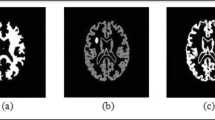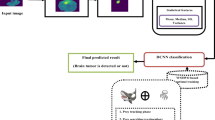Abstract
Automated suspicious region segmentation has become a crucial need for the experts dealing with numerous images containing contrast-based lesions in MRI. Not all solutions, however, are based on mathematical infrastructure or providing adequate flexibility. On the other hand, segmentation of low-contrast lesions is very challenging for researchers; therefore, advanced magnetic resonance imaging (MRI) experiments are not commonly used in researches. Given the need of repeatability and adaptability, we present an automated framework for intelligent segmentation of brain lesions by wavelet imaging and fuzzy 2-means. Besides the general use of the wavelets in image processing, which is edge detection; we employed the second-order Ricker-type wavelets as the core of our novel imaging framework for low-contrast lesion segmentation. We firstly introduced the mathematical basis of several Ricker wavelet functions, which are in symmetrical form satisfying finite-energy and admissibility conditions of mother wavelets. Afterwards, we investigated three types of Ricker wavelets to apply on our clinical dataset containing susceptibility-weighted (SW) and minimum intensity projection SW (mIP-SW) images with barely-visible lesions. Finally, we adjusted the system parameters of the wavelets for optimization and post-segmentation by fuzzy 2-means. According to the preliminary results of the clinical experiments we conducted, our framework provided 93.53% average dice score (DSC) for SWI by Ricker-3 and 92.56% for mIP-SWI by Ricker-2 wavelet, as the main performance criteria of segmentation. Despite the lack of SWI or mIP-SWI experiments in the public datasets, we tested our framework with BraTS 2012 training sets containing real images with visible lesions and achieved an average of 88.13% DSC with 11.66% standard deviation by re-optimized framework for whole lesion segmentation, which is one of the highest among other relevant researches. In detail, 87.52% DSC for LG datasets with 11.32% standard deviation; while 88.34% DSC for HG datasets with 11.77% standard deviation are calculated.









Similar content being viewed by others
References
Alpar O (2019) A novel fuzzy curvature method for recognition of anterior forearm subcutaneous veins by thermal imaging. Expert Syst Appl 120:33–42
Alpar O (2020) Nakagami imaging with related distributions for advanced thermogram pseudocolorization. J Therm Biol 93:102704
Alpar, O., & Krejcar, O. (2018a). A comparative study on chrominance based methods in dorsal hand recognition: single image case. International conference on industrial, engineering and other applications of applied intelligent systems (pp. 711–721). Springer, Cham
Alpar, O., & Krejcar, O. (2018b). Detection of irregular thermoregulation in hand thermography by fuzzy C-means. In international conference on bioinformatics and biomedical engineering (pp. 255–265). Springer, Cham
Alpar O, Krejcar O, Dolezal R (2021) Distribution-based imaging for multiple sclerosis lesion segmentation using specialized fuzzy 2-means powered by Nakagami transmutations. Appl Soft Comput 108:107481
Amin J, Sharif M, Raza M, Saba T, Sial R, Shad SA (2020) Brain tumor detection: a long short-term memory (LSTM)-based learning model. Neural Comput & Applic 32(20):15965–15973
Aslani S, Dayan M, Storelli L, Filippi M, Murino V, Rocca MA, Sona D (2019) Multi-branch convolutional neural network for multiple sclerosis lesion segmentation. NeuroImage 196:1–15
Ayadi W, Elhamzi W, Charfi I, Atri M (2021) Deep CNN for brain tumor classification. Neural Process Lett 53(1):671–700
Billast M, Meyer MI, Sima DM, Robben D (2019) Improved inter-scanner MS lesion segmentation by adversarial training on longitudinal data, International MICCAI Brainlesion workshop (pp. 98–107). Springer, Cham
Bose A, Mali K (2021) Type-reduced vague possibilistic fuzzy clustering for medical images. Pattern Recogn 112:107784
Chithra PL, Dheepa G (2020) Di-phase midway convolution and deconvolution network for brain tumor segmentation in MRI images. Int J Imaging Syst Technol 30(3):674–686
Corbat L, Nauval M, Henriet J, Lapayre JC (2020) A fusion method based on deep learning and case-based reasoning which improves the resulting medical image segmentations. Ions Expert Systems with Appl 147:113200
Cordier N, Menze B, Delingette H, Ayache N (2013) Patch-based segmentation of brain tissues. MICCAI challenge on multimodal brain tumor segmentation (pp. 6-17). IEEE.
Flores WG, de Albuquerque Pereira WC (2017) A contrast enhancement method for improving the segmentation of breast lesions on ultrasonography. Comput Biol Med 80:14–23
Haacke EM, Xu Y, Cheng YC, Reichenbach JR (2004) Susceptibility weighted imaging (SWI). Magnetic Resonance Med: Off JInt Soc Magnetic Resonance Med 52(3):612–618
Havaei M, Davy A, Warde-Farley D, Biard A, Courville A, Bengio Y, Larochelle H (2017) Brain tumor segmentation with deep neural networks. Med Image Anal 35:18–31
Khosravanian A, Rahmanimanesh M, Keshavarzi P, Mozaffari S (2021) Fast level set method for glioma brain tumor segmentation based on Superpixel fuzzy clustering and lattice Boltzmann method. Comput Methods Prog Biomed 198:105809
Khouloud S, Ahlem M, Fadel T (2021) W-net and inception residual network for skin lesion segmentation and classification. Appl Intell. https://doi.org/10.1007/s10489-021-02652-4
Kistler M, Bonaretti S, Pfahrer M, Niklaus R, Büchler P (2013) The virtual skeleton database: an open access repository for biomedical research and collaboration. J Med Internet Res 15(11):e245
Kouhi A, Seyedarabi H, Aghagolzadeh A (2020) Robust FCM clustering algorithm with combined spatial constraint and membership matrix local information for brain MRI segmentation. Expert Syst Appl 146:113159
Kumar SN, Fred AL, Varghese PS (2019) Suspicious lesion segmentation on brain, mammograms and breast MR images using new optimized spatial feature based super-pixel fuzzy c-means clustering. J Digit Imaging 32(2):322–335
Kumar V, Webb JM, Gregory A, Denis M, Meixner DD, Bayat M, Alizad A (2018) Automated and real-time segmentation of suspicious breast masses using convolutional neural network. PLoS One 13(5):e0195816
Lei X, Yu X, Chi J, Wang Y, Zhang J, Wu C (2021) Brain tumor segmentation in MR images using a sparse constrained level set algorithm. Expert Syst Appl 168:114262
Li F, Shang C, Li Y, Shen Q (2020) Interpretable mammographic mass classification with fuzzy interpolative reasoning. Knowl-Based Syst 191:105279
Meier R, Bauer S, Slotboom J, Wiest R, Reyes M (2013) A hybrid model for multimodal brain tumor segmentation. Multimodal Brain Tumor Segm, (pp. 31-37.).
Menze BH, Jakab A, Bauer S, Kalpathy-Cramer J, Farahani K, Kirby J et al (2014) The multimodal brain tumor image segmentation benchmark (BRATS). IEEE Trans Med Imaging 34(10):1993–2024
Nair T, Precup D, Arnold DL, Arbel T (2020) Exploring uncertainty measures in deep networks for multiple sclerosis lesion detection and segmentation. Med Image Anal 59:101557
Natarajan A, Kumarasamy S (2019) Efficient segmentation of brain tumor using FL-SNM with a metaheuristic approach to optimization. J Med Syst 43(2):25–39
Nie D, Shen D (2020) Adversarial confidence learning for medical image segmentation and synthesis. Int J Comput Vision, 1-20.
Peng SJ, Lee CC, Wu HM, Lin CJ, Shiau CY, Guo WY, Yang HC (2019) Fully automated tissue segmentation of the prescription isodose region delineated through the gamma knife plan for cerebral arteriovenous malformation (AVM) using fuzzy C-means (FCM) clustering. NeuroImage: Clin 21:101608
Pramanik S, Banik D, Bhattacharjee D, Nasipuri M, Bhowmik MK, Majumdar G (2018) Suspicious-region segmentation from breast Thermogram using DLPE-based level set method. IEEE Trans Med Imaging 38(2):572–584
Rehman ZU, Naqvi SS, Khan TM, Khan MA, Bashir T (2019) Fully automated multi-parametric brain tumour segmentation using superpixel based classification. Expert Syst Appl 118:598–613
Reza S, Iftekharuddin KM (2013) Multi-class abnormal brain tissue segmentation using texture. Multimodal Brain Tumor Segment, (pp. 38-42).
Shivhare SN, Kumar N (2020) Brain tumor detection using manifold ranking in flair mri. Proceedings of ICETIT 2019. Springer, Cham, pp 292–305
Singh VK, Rashwan HA, Romani S, Akram F, Pandey N, Sarker MM, Torrents-Barrena J (2020) Breast tumor segmentation and shape classification in mammograms using generative adversarial and convolutional neural network. Expert Syst Appl 139:112855
Soltaninejad M, Yang G, Lambrou T, Allinson N, Jones TL, Barrick TR, Ye X (2017) Automated brain tumour detection and segmentation using superpixel-based extremely randomized trees in FLAIR MRI. Int J Comput Assist Radiol Surg 12(2):183–203
Song LI, Geoffrey KF, Kaijian HE (2020) Bottleneck feature supervised U-net for pixel-wise liver and tumor segmentation. Expert Syst Appl 145:113131
Sun J, Peng Y, Guo Y, Li D (2021) Segmentation of the multimodal brain tumor image used the multi-pathway architecture method based on 3D FCN. Neurocomputing 423:34–45
Tan TY, Zhang L, Neoh SC, Lim CP (2018) Intelligent skin cancer detection using enhanced particle swarm optimization. Knowl-Based Syst 158:118–135
Tan TY, Zhang L, Lim CP (2020) Adaptive melanoma diagnosis using evolving clustering, ensemble and deep neural networks. Knowl-Based Syst 187:104807
Tustison N, Wintermark M, Durst C, Avants B (2013) Ants andarboles. Multimodal Brain Tumor Segment, pp 47–50
Usman K, Rajpoot K (2017) Brain tumor classification from multi-modality MRI using wavelets and machine learning. Pattern Anal Applic 20(3):871–881
Wang G, Zuluaga MA, Li W, Pratt R, Patel PA, Aertsen M, Vercauteren T (2018) DeepIGeoS: a deep interactive geodesic framework for medical image segmentation. IEEE Trans Patt Anal Mach Intell 41(7):1559–1572
Wang H, Hu J, Song Y, Zhang L, Bai S, Yi Z (2021) Multi-view fusion segmentation for brain glioma on CT images. Appl Intell. https://doi.org/10.1007/s10489-021-02784-7
Wang J, Liu M, Zhang C, Xu H, Zhang L, Zhao Y (2020) An adaptive sparse Bayesian model combined with probabilistic label fusion for multiple sclerosis lesion segmentation in brain MRI. Futur Gener Comput Syst 105:695–704
Wang W, Chen Z, Yuan X, Wu X (2019) Adaptive image enhancement method for correcting low-illumination images. Inf Sci 496:25–41
Wang ZZ (2021) Automatic localization and segmentation of the ventricle in magnetic resonance images. IEEE Trans Circuits Syst Video Technol 31(2):621–631
Wang ZZ, Yang YM (2018) A non-iterative clustering based soft segmentation approach for a class of fuzzy images. Appl Soft Comput 70:988–999
Zhang W, Yang G, Huang H, Yang W, Xu X, Liu Y, Lai X (2021) ME-net: multi-encoder net framework for brain tumor segmentation. Int J Imaging Syst Technol, 1-15.
Zhou X, Li X, Hu K, Zhang Y, Chen Z, Gao X (2021) ERV-net: an efficient 3D residual neural network for brain tumor segmentation. Expert Syst Appl 170:114566
Acknowledgements
The authors of the article are grateful to the Clinic of Neurosurgery, University Hospital of Hradec Kralove, for providing MRI sequence of infiltrative tumor case under IT4Neuro project. The study conforms to the rules of University Hospital Ethical Board and it was anonymized accordingly so as to protect the privacy and dignity of any involved people. The work was funded by the project IT4Neuro (degeneration), reg. nr. CZ.02.1.01/0.0/0.0/ 18_069/0010054, University of Hradec Kralove, Faculty of Informatics and Management, Czech Republic.
Author information
Authors and Affiliations
Corresponding authors
Ethics declarations
Competing interests
All authors declare no conflict of interest.
Additional information
Publisher’s note
Springer Nature remains neutral with regard to jurisdictional claims in published maps and institutional affiliations.
Rights and permissions
About this article
Cite this article
Alpar, O., Dolezal, R., Ryska, P. et al. Low-contrast lesion segmentation in advanced MRI experiments by time-domain Ricker-type wavelets and fuzzy 2-means. Appl Intell 52, 15237–15258 (2022). https://doi.org/10.1007/s10489-022-03184-1
Accepted:
Published:
Issue Date:
DOI: https://doi.org/10.1007/s10489-022-03184-1




